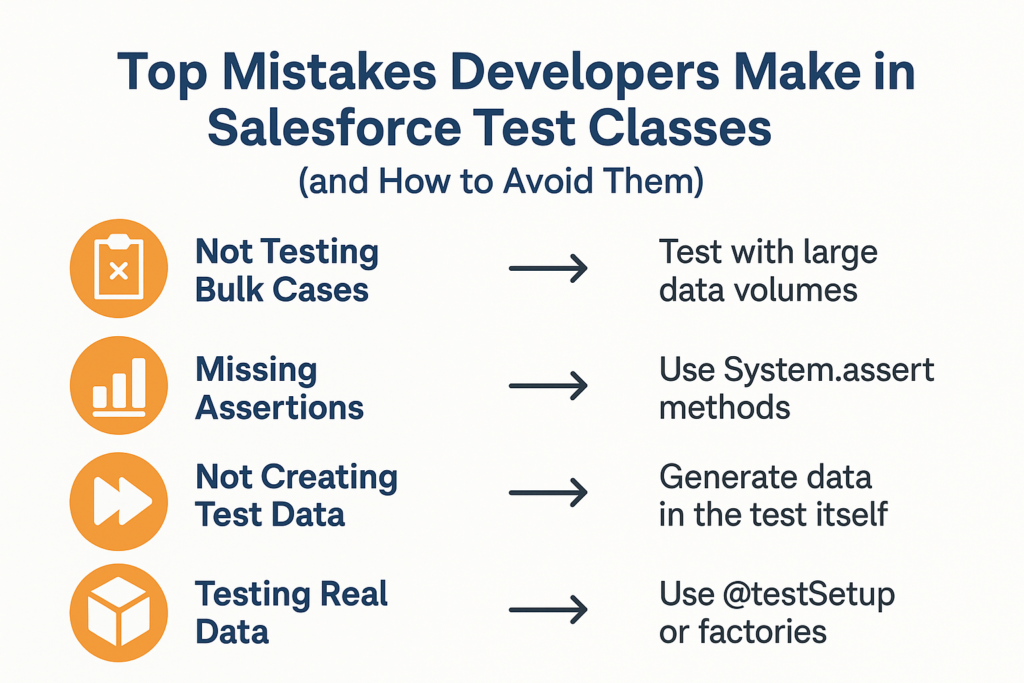🚫 Top Mistakes Developers Make in Salesforce Test Classes (and How to Avoid Them)
In Salesforce development, writing robust Apex Test Classes is not just a best practice—it’s a requirement. Salesforce mandates at least 75% code coverage for deployment to production. But test classes are not only about coverage; they’re about ensuring your code works reliably in different scenarios.
Unfortunately, many developers fall into common pitfalls that reduce the quality, reliability, and maintainability of test classes. In this blog, we’ll explore the top mistakes developers make in Salesforce test classes—and how to avoid them.
1. Focusing Only on Code Coverage Instead of Quality
Mistake: Developers often write “dummy” test methods just to push the code coverage above 75%. These tests don’t validate real business logic.
Example (Bad):
@isTest
private class DummyTest {
static testMethod void coverCode() {
MyClass obj = new MyClass();
obj.myMethod(); // No assertions, no logic check
}
}
How to Avoid:
- Always include assertions to check expected outcomes.
- Test both positive and negative scenarios.
- Treat test classes as quality assurance, not just a deployment requirement.
2. Not Creating Test Data Within the Test Class
Mistake: Using existing org data instead of creating test-specific records. This leads to inconsistent test results across sandboxes and environments.
How to Avoid:
- Use a Test Data Factory class to generate consistent test data.
- Leverage @testSetup to create reusable test records.
Example (Good):
@testSetup
static void setupData() {
Account acc = new Account(Name = ‘Test Account’);
insert acc;
}
3. Forgetting Bulk Testing
Mistake: Writing test methods that only handle a single record. In real life, triggers and classes often run in bulk.
How to Avoid:
- Always test with multiple records (e.g., inserting 200 records).
- Ensure your code runs efficiently under bulk scenarios.
4. Not Testing Negative Scenarios and Exceptions
Mistake: Developers only test the “happy path.” But in production, errors happen—missing data, null values, DML exceptions, etc.
How to Avoid:
- Write test cases for failure scenarios (e.g., invalid data, missing required fields).
- Use System.assertException() to validate exception handling.
5. Hardcoding IDs or Environment-Specific Data
Mistake: Using hardcoded record IDs or relying on environment-specific data like Record Types or Profiles. This makes tests fail when deployed to another org.
How to Avoid:
- Query metadata dynamically (SELECT Id FROM RecordType WHERE DeveloperName=’XYZ’).
- Avoid hardcoding UserIds, ProfileIds, or RecordTypeIds.
6. Ignoring Test.startTest() and Test.stopTest()
Mistake: Not wrapping code execution inside Test.startTest() and Test.stopTest(). This causes inaccurate governor limit usage and unreliable async testing.
How to Avoid:
- Always use Test.startTest() before calling the actual logic.
- End with Test.stopTest() to simulate a real transaction.
7. Not Isolating Tests (Dependency Between Tests)
Mistake: Writing tests that depend on other test methods’ data. If one fails, others fail too.
How to Avoid:
- Keep each test method independent.
- Use @testSetup for common data instead of sharing across methods.
8. Forgetting to Test for Different Profiles and Permissions
Mistake: Only testing with the default running user. In reality, different users may not have the same access.
How to Avoid:
- Create test users with different profiles/permissions.
- Use System.runAs(user) to simulate user behavior.
9. Not Mocking Callouts in Test Classes
Mistake: Making real HTTP callouts in test classes. Salesforce blocks callouts in tests unless mocked.
How to Avoid:
- Implement a Mock Callout using HttpCalloutMock.
- Always verify callout response logic inside the test.
10. Not Maintaining Test Classes Over Time
Mistake: Treating test classes as one-time work. Over time, business logic changes but test classes are left outdated.
How to Avoid:
- Regularly update test classes alongside code changes.
- Follow naming conventions for easy identification (MyClassTest).
- Review test classes during code reviews.
🎯 Conclusion
Test classes in Salesforce are more than a deployment checklist—they are the foundation of reliable, scalable, and future-proof code. By avoiding these common mistakes, developers can:
✅ Improve code quality
✅ Catch bugs before they hit production
✅ Ensure smooth deployments across environments
Remember: A good test class doesn’t just cover code—it covers logic, performance, and edge cases.

